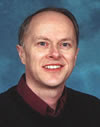He was a small-town doctor in the middle of America, and while tending to the health of many of the residents of Hastings, Nebraska, this fellow must have cared about more than the physical bodies he touched. Elijah Taylor Cassel had been practicing medicine for decades, but as his life continued from the 19th into the 20th Century, he practiced another pursuit that outlived his role as a doctor. Maybe he’d felt for some time that his poetic words “I Am a Stranger Here” (aka “The King’s Business”) were about exchanging the physician’s coat for another, something that he eventually did as he entered his later years. To the common folk, Elijah’s words that he was a foreigner in a place where he was well-known must have seemed a bit peculiar. Was he lost, or beginning to lose his mind? He eventually did leave Nebraska, making a couple of other stops along the way before going somewhere else for good.
Elijah Taylor Cassel had spent practically all of his adult life in Hastings, Nebraska as a doctor, yet he began the poem, which his wife (Flora) put to music, by saying he was a stranger in 1902. How could a 53-year-old long-time resident, most likely one of relatively few doctors in this small community, say that? That he was also a hymnwriter, with the collaboration of his wife, was probably not a surprise to those patients that the Cassels got to know well, however. He authored a few dozen poems that his wife helped turn into hymns, so his faith expression was certainly not a secret, and we can imagine it could have mingled at times with his professional life. Was Elijah unfulfilled in his medical role, leading him to say throughout his song’s three verses that his ‘business’ was in fact ‘my King’s’? Though he was a physician, he called himself an ‘ambassador’ from another plane of existence (v.1). By 1910, Elijah had formally entered church ministry in Denver, Colorado and stayed there and in nearby Fort Morgan for the next 11 years. That he entered ministry so late in life – after he turned 60 years old – says something about this doctor-hymnwriter who decided to become a fulltime minister at a time when most people would have retired. He wasn’t just composing rhyming words many years before, but rather expressing feelings that resonated from deep within himself. He wanted to keep doing the ‘king’s business’, in an even more intensive way than he had been doing. How many of us can say that an internal fire stayed hot or grew hotter after one’s 60th birthday?
What was it, particularly, that compelled Elijah Cassel late in his life to pursue formal ministry? We can only speculate that he finally took a step that he’d been considering. Was it a lifetime of watching patients deal with sicknesses that coaxed Elijah that the human body needed a more permanent solution to mortality? Dr. Cassel had come a long way himself, and seen a lot by the time he changed jobs. Born in Indiana, educated in Illinois, practiced medicine in Nebraska, ministered in Colorado, Elijah spent his last years in California before going on to his reward. Five states in one lifetime may have told this doctor that nothing is forever, at least on planet Earth. He must have prescribed many remedies after conducting countless examinations and running tests on ailing people. Do you think it occurred to him more than once that another physician was so much wiser and more skillful than he was? That physician-King was the one Elijah was really recommending to his patients all along.
See here for short biography on the author: http://www.hymntime.com/tch/bio/c/a/s/s/cassel_et.htm
See here for all three verses and the refrain of the song: https://hymnary.org/text/i_am_a_stranger_here_within_a_foreign_la
See here for obituary on the author: https://www.findagrave.com/memorial/82071031/elijah-taylor-cassel



